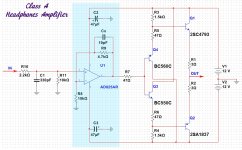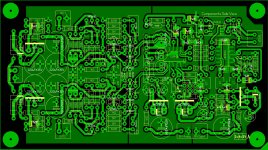Blade Runner SACD
You have good taste, then.
Now I feel like watching DUNE.
You have good taste, then.
Now I feel like watching DUNE.
Maybe to do opAMPs on output - LT1469 in i-v and LT1122 in filter (and made on output small class A amplifier as optional)? 🙂
Attachments
The biggest advantage (after drive capability) for a discrete output stage is the ability to keep the switching noise away from the opamp's power rails through judicious filtering. I suggest LC or RC on the opamp's power or alternatively shunt regs.
The biggest advantage (after drive capability) for a discrete output stage is the ability to keep the switching noise away from the opamp's power rails through judicious filtering. I suggest LC or RC on the opamp's power or alternatively shunt regs.
I think that I'll build 2 DACs with discrete and opAMPs output, and compared them. 🙂
Maybe to do opAMPs on output - LT1469 in i-v and LT1122 in filter (and made on output small class A amplifier as optional)? 🙂
Nice idea.
You can consider LT1363 in I/V and LME49990 in LPF.
Intense detail + virgin purity.
Last edited:
Thanks for recommendation, but I don't like lt1363/64 and lme49990 (and 49860), the sound is very good, but a little not mine. 🙂
Starting to draw AD1853+LT1469+LT1122. 🙂
p/s: sorry for my english. 🙂
Starting to draw AD1853+LT1469+LT1122. 🙂
p/s: sorry for my english. 🙂
Last edited:
I don't like LME49860 either, only LME49990 in high gain with LME49990 buffer, 4x total.
They say LT1363 sounds better in Class-A bias, I haven't tried that yet.
I will order LT1469 and LT1122 later. 🙂
They say LT1363 sounds better in Class-A bias, I haven't tried that yet.
I will order LT1469 and LT1122 later. 🙂
I don't like LME49860 either, only LME49990 in high gain with LME49990 buffer, 4x total.
They say LT1363 sounds better in Class-A bias, I haven't tried that yet.
I will order LT1469 and LT1122 later. 🙂
PCB for AD1853+discrete (not my).
I draw 2 layers PCB for AD1853+opAMPs, then will draw 2 layers PCB for discrete output. 🙂
Attachments
Have a look at this schematic for a few ideas
http://www.diyaudio.com/forums/solid-state/255236-opamp-based-power-amp.html
Later in the thread, LTspice simulation achieves -160 dB!
http://www.diyaudio.com/forums/solid-state/255236-opamp-based-power-amp.html
Later in the thread, LTspice simulation achieves -160 dB!
Nice project.
Not enough information about the sound of discrete output: "the sound of discrete output differs from the traditional opAMPs" and all. Someone like - someone hates.
Have a look at this schematic for a few ideas
http://www.diyaudio.com/forums/solid-state/255236-opamp-based-power-amp.html
Later in the thread, LTspice simulation achieves -160 dB!
and now we rebuilding AD844 and LT1363 on discrete elements... 😱😀
Have a look at this schematic for a few ideas
http://www.diyaudio.com/forums/solid-state/255236-opamp-based-power-amp.html
Later in the thread, LTspice simulation achieves -160 dB!
I think, that Jean Hiraga's Le Monstre 8W will spread this AMP. 😉
Not enough information about the sound of discrete output: "the sound of discrete output differs from the traditional opAMPs" and all. Someone like - someone hates.
I will link you to a Swiss paper on discrete tomorrow or next day, on phone at the moment.
and now we rebuilding AD844 and LT1363 on discrete elements... 😱😀
What?
 !!
!!I think, that Jean Hiraga's Le Monstre 8W will spread this AMP. 😉
I want to build a DIY speaker amp, at the moment I only have "JLH", what do you think of Class-D? Which is the best?
I will link you to a Swiss paper on discrete tomorrow or next day, on phone at the moment.
aaaa, not understood. 🙂
What?!!
opAMP build on discrete elements : D
I want to build a DIY speaker amp, at the moment I only have "JLH", what do you think of Class-D? Which is the best?
Class D for car's subwoofer only. JLH much worse than Jean Hiraga's Le Monstre 8W and Super Class A 20/30W. I almost smashed JLH 1996 after made and heard Hiraga. 🙂😀
What does a current out DAC need?
Low Input resistance of the I/V (although a switched capacitor output stage as the AD1853 is not that sensitive, R2R DACS are much more picky). This impedance should be as flat as possible over a broad frequency range, as the DAC spits out, inherently, a high amount of HF components.
The shown discrete Output stage is NOT an OP Amp style stage, but common base open loop.
It has a low input impedance, which rises way later in the frequency band than a op amp I/V (which relies only to a high Loop gain, and it decreases quickly with rising frequency.
I suggest you to leave the discrete output stage as it is (at least from a topology view). You may look to increase the bias current through VT4-8, it gets better when their bias current is >> max current swing of AD1853 (AFAIR +/-3mA).
I'd bias them at least to 10mA.
Anyway, common base stages are the way to go for DAC I/V.
Low Input resistance of the I/V (although a switched capacitor output stage as the AD1853 is not that sensitive, R2R DACS are much more picky). This impedance should be as flat as possible over a broad frequency range, as the DAC spits out, inherently, a high amount of HF components.
The shown discrete Output stage is NOT an OP Amp style stage, but common base open loop.
It has a low input impedance, which rises way later in the frequency band than a op amp I/V (which relies only to a high Loop gain, and it decreases quickly with rising frequency.
I suggest you to leave the discrete output stage as it is (at least from a topology view). You may look to increase the bias current through VT4-8, it gets better when their bias current is >> max current swing of AD1853 (AFAIR +/-3mA).
I'd bias them at least to 10mA.
Anyway, common base stages are the way to go for DAC I/V.
JLH much worse than Jean Hiraga
How does the Hiraga sound?
Plus, from where did you purchase the Hiraga PCB? I have JLH 2001.
DAC will be not work on low impendance, 1 mA maximum output current. 10 mA bias can damage BJT (300 mW maximum).What does a current out DAC need?
as current is >> max current swing of AD1853 (AFAIR +/-3mA).Low Input resistance of the I/V (although a switched capacitor output stage as the AD1853 is not that sensitive, R2R DACS are much more picky). This impedance should be as flat as possible over a broad frequency range, as the DAC spits out, inherently, a high amount of HF components.
The shown discrete Output stage is NOT an OP Amp style stage, but common base open loop.
It has a low input impedance, which rises way later in the frequency band than a op amp I/V (which relies only to a high Loop gain, and it decreases quickly with rising frequency.
I suggest you to leave the discrete output stage as it is (at least from a topology view). You may look to increase the bias current through VT4-8, it gets better when their bi
I'd bias them at least to 10mA.
Anyway, common base stages are the way to go for DAC I/V.
I think too - build DAC with opAMPs (and to make discrete output for interest).
About R2R - do you have good scheme on PCM1702 (it's alone multibit, that I can to get in my city (PCM1702U-K))?
- Status
- Not open for further replies.
- Home
- Source & Line
- Digital Line Level
- DAC AD1853 with discrete output

